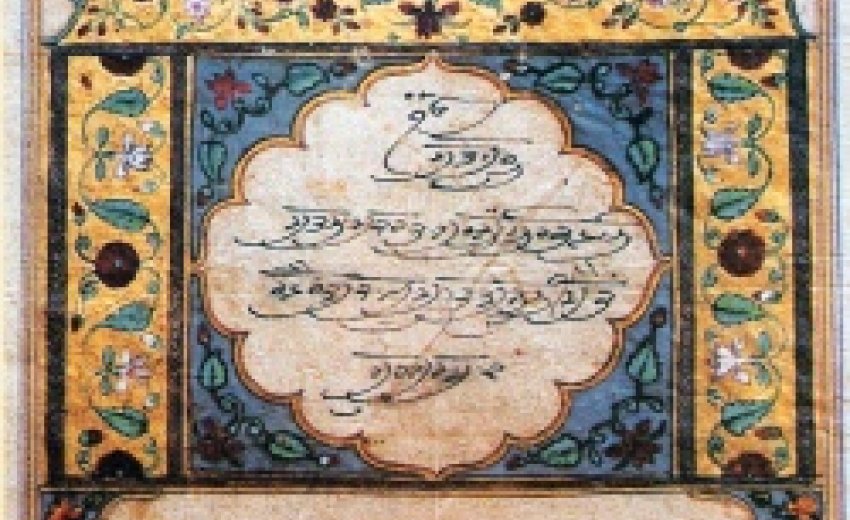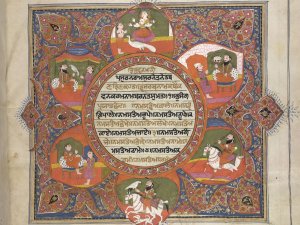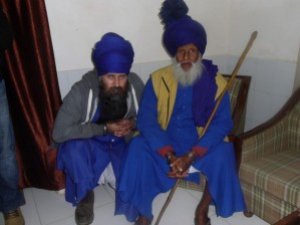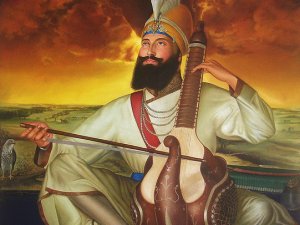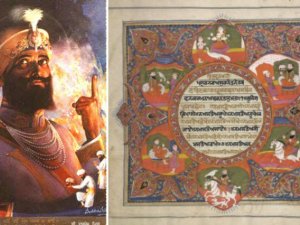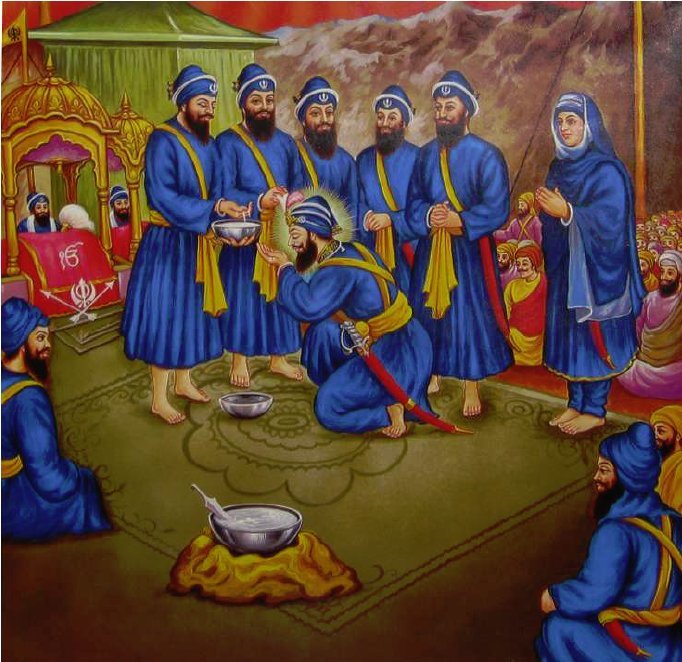
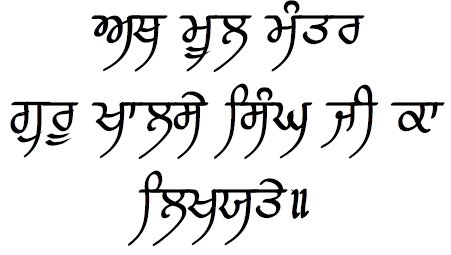
Ath Mūl Maṅtar Gurū Khālse Siṅgh jī kā Likhayate
By Akali Nihang Dr Kamalroop Singh
HTTP://WWW.ARCHIMEDESPRESS.CO.UK
What is Ath Mūl Maṅtar Gurū Khālse Siṅgh jī kā Likhayate?
This composition is found in the current 'Khalsa Nitnem' by the Shiromani Khalsa Panth Akali, Buddha Dal, Panjva Takht, Chakarvarti, Chalda Vahir, Vishav, the central organisation of the Akali Nihang Singhs. It contains the details of the first Khalsa initiation or khande-ki-pahul ceremony and information about the Panj Piare and the Rahit of the Khalsa. The name translates to the 'Now is Written the Root Mantra of the Singhs of the Guru Khalsa.' As the name suggests, it is the written history about how the Khalsa came into being as recorded by scribes in the Guru's court.
For the benefit of the Sikh Sangat and scholars alike this composition has been reproduced in the original Gurmukhi, translated and transliterated for the first time.
What is its history?
According to the tradition it was said in the Court by the Tenth Guru, on the Khalsa inauguration at Vaisakhi, and recorded by scribes. The Guru ordered that the names of the Panj Piare and Panj Mukate to be immortalized forever. Many old pothia and manuscripts from the period of the Guru, and from slightly later, contain this composition. There are a number of eighteenth century manuscripts with this composition, for an example see Guru Nanak Dev ji University, Amritsar, MS 769 j, which is from around 1722 AD/ 1779 VS.
The history of the Panj Mukate is not well known, the five (panj) liberated
ones (mukate), were the five Sikhs, who according to Bhai Daya Singh`s Rahitnama, were the first after the Panj Piare to receive the Khalsa
initiation by the hands of Guru Gobind Singh on the historic Vaisakhi day.
They were the Panj Singhs who stood up after the Panj Piare when the Guru
asked for five Sikhs to offer their head. The Guru said 'only five were
required, but since you five have also stood up, you will be remembered as
the Panj Mukate.' They were Ram Singh, Fateh Singh, Deva Singh, Tahil
Singh and Isar Singh. They are also said to have merged into divine light
through the repetition of Vahiguru. They are ceremonially represented by
the five Singhs with the Nishan Sahibs walking in front of the Panj Piare.
According to Bhai Chaupa Singh, the Hazuri Rahitnama, ascribed to him,
was first written in draft by the Panj Mukate:
The eternal and supreme Guru has declared, the gathered community (sarabat sangat) is my Khalsa. All should observe the Guru's Rahit.' [The injunctions of the Rahit were recorded] by Enlightened Sikhs (mukate Sikh) in the presence of the eternal and supreme Master.
These devout Sikhs studiously compiled a rahit-nama so that Gursikhs might act as the Guru has prescribed. The Sikh Rahit is as follows: Pay heed to neither Brahma [the God of the Hindus] nor to Muhammad [the Prophet of the Muslims]. Obey only the commands of your own Gurus. If help be needed the Gurus will furnish it [to those who accept] their testimony recorded in the Granth:
I praise and adore my Guru a hundred times a day, he who lifts men to the ranks of the gods, swiftly, without delay.2
The Satguru will sustain [the Gursikh] both in this world and the next. The Gursikh should therefore obey the Rahit. Chaupa Singh Rahit-nama, W. H. McLeod, p. 251.
McLeod then quotes from Bhai Kesar Singh Chhibbar to elaborate on who
the Mukate were in his introduction:
The mukate Sikhs are those who shall remain after I have gone. The Turks will issue ordinances against the Panth and pursue its members in their attempt to destroy all. They who [in these times of persecution] uphold their Sikh allegiance shall be known as mukate. Striving always to sustain their faith as Sikhs. Chaupa Singh Rahit- nama, W. H. McLeod, p. 46.
According to the The Encyclopaedia of Sikhism, an old manuscript of Bhai Prahlad Singh's Rahitnama is said to contain a note associating Ram Singh and Deva Singh with the village of Bughiana, in Lahore district, Tahil Singh and Isar Singh with Dallvan, in present day Amritsar district and Fateh Singh with Khurdpur Mangat, perhaps the same as Guru Mangat in Lahore district. The name of Ram Singh also occurs among the twenty-five mukate mentioned in Kuir Singh, Gurbilas Patshahi 10.' According to Sarup Singh Kaushish in Guru kian Sakhian, Deva Singh and Isar Singh fell as martyrs in the battle of Chamkaur on 7 December 1705.
What does it contain?
It contains the names of the first Panj Piare and their previous incarnations, as Bhagats whose Bani is recorded in the Adi Guru Granth Sahib, their respective castes and where they were born. This is to show that all the different castes drank from the same bowl or batta, hence breaking the Khalsa out of the Brahmanic caste system. It also shows that as the Guru's light came again in the form of different Guru's, similarly the Bhagats were avatar also. It records that the Guru stood in front of these five and requested Amrit, and the names of the Panj Mukate. The author then gives the instructions of not meeting reprobate groups, killers of daughters, and clean shaved ones. It also talks about Singhs not killing other Singhs (bans ghat). The importance of the Gurmantra is stressed and the avoidance of those who do not do it, and to stand at the door to get the darshan of those that do.
Why and when do we do it?
The Mul Mantra of the Guru Khalsa is very important for all Sikhs, and to recite it daily is important for all Khalsa Sikhs, in fact Nihang Singhs read this as a part of their amritvela Nitnem. There are spiritual reasons why it is read and one has to go to a recognised teacher from within the Nihang Singh Khalsa to learn about this.
Also see my articles on the Nitnem and Arti-Arta also available on scribd.
With the blessings of the Jathedars of Buddha Dal
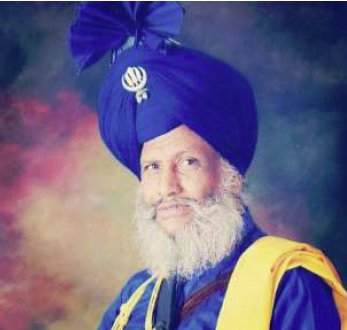
In memory of the last head of the Shiromani Khalsa Panth Akali Buddha Dal Panjva Takht Chalda Vahir Chakarvarti, Vishav, Singh Sahib 96 Crori Jathedar Akali Baba Surjit Singh Nihang Singh. Who is did Akal chalana in jail, in circumstances where the SGPC and Akali Dal making their own puppet leader Balbir Singh. Please visit www.babasurjeetsingh.com to spread awareness about this injustice. This is what the Chinese government have done to his holiness the Dalai Lama and the Pancham Lama. We cannot allow this to happen to the head of the Khalsa Panth.
The new head is Akali Nihang 96 Crori Jathedar Baba Prem Singh of Mata Sahib Kaur's Tap Asthan at Sachkhand Sri Hazur Sahib.
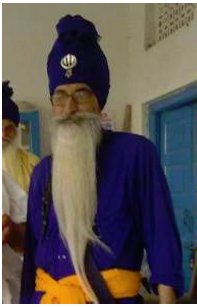 |
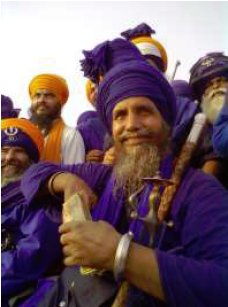 |
| Jathedar Baba Prem Singh and (right) Singh Sahib Jathedar Akali Baba Joginder Singh | |
While Baba Surjit Singh was is in jail, Singh Sahib Jathedar Akali Baba Joginder Singh a respected and enlightened Mahapurush took over ceremonial duties of the Shiromani Khalsa Panth Akali Buddha Dal Panjwa Takht Chalda Vahir Chakrvarti, Vishav. Please visit Baba ji at Gurdwara Dam Dama Sahib, Rakhba.
|
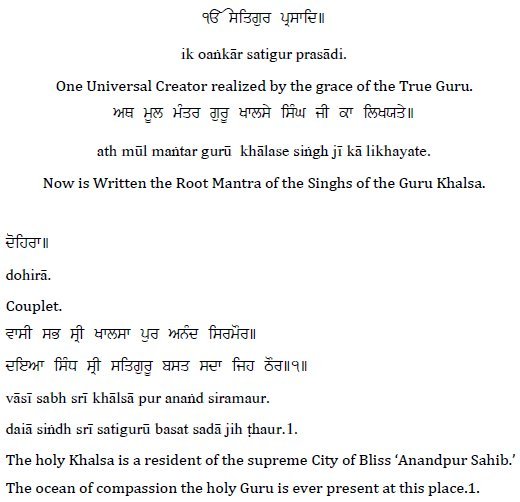
Fur further reading Click on Link: http://www.scribd.com/doc/241513302/Mul-Mantra-Khalsa
References
Bhai Gurdas, Vārāṅ.
Adi Sri Guru Granth Sahib
Sri Dasam Granth Sahib
Sri Sarbloh Granth Sahib
Bhai Bala Janam S?kh?
Tankhānāmah Bhai Nand Lal
http://library.gndu.ac.in/Manuscripts.asp
http://www.scribd.com/doc/130906016/The-History-of-the-Nitnem-
B%C4%80%C5%86i%C4%80-Akali-Dr-Kamalroop-Singh-Nihang
http://www.scribd.com/doc/183005595/Arati-Arata-by-Dr-Kamalroop-
Singh-Akali-Nihang-pdf
www.searchgurbani.com
www.sikhitothemax.com
www.sridasam.com
http://www.sridasamgranthsahibji.com
C. Shackle, An Introduction to the Sacred Language of the Sikhs.
